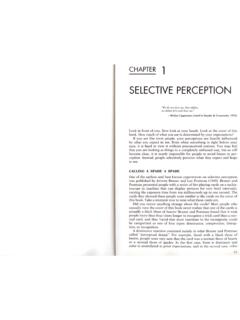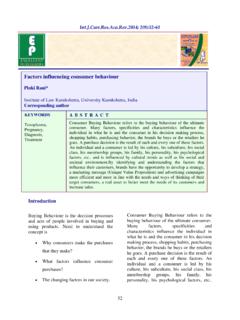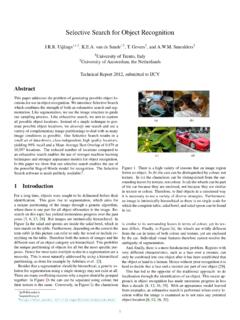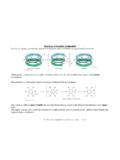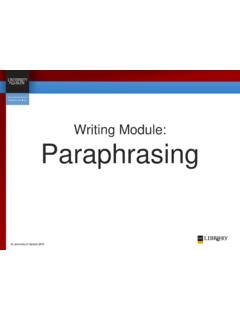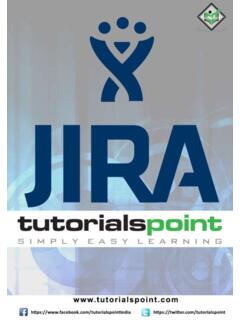Transcription of Selective Search for Object Recognition
1 Int J Comput VisDOI Search for Object RecognitionJ. R. R. Uijlings K. E. A. van de Sande T. Gevers A. W. M. SmeuldersReceived: 5 May 2012 / Accepted: 11 March 2013 Springer Science+Business Media New York 2013 AbstractThis paper addresses the problem of generatingpossible Object locations for use in Object Recognition . Weintroduce Selective Search which combines the strength ofboth an exhaustive Search and segmentation. Like segmen-tation, we use the image structure to guide our samplingprocess. Like exhaustive Search , we aim to capture all possi-ble Object locations. Instead of a single technique to generatepossible Object locations, we diversify our Search and use avariety of complementary image partitionings to deal withas many image conditions as possible. Our Selective searchresults in a small set of data-driven, class-independent, highquality locations, yielding 99% recall and a Mean AverageBest Overlap of at 10,097 locations.
2 The reduced num-ber of locations compared to an exhaustive Search enablesthe use of stronger machine learning techniques and strongerappearance models for Object Recognition . In this paper weshow that our Selective Search enables the use of the powerfulBag-of-Words model for Recognition . The Selective searchsoftware is made publicly available (Software: ~ ).1 IntroductionFor a long time, objects were sought to be delineated beforetheir identification. This gave rise to segmentation, whichaims for a unique partitioning of the image through a genericalgorithm, where there is one part for all Object silhouettesinthe image. Research on this topic has yielded tremendousJ. R. R. Uijlings (B)University of Trento, Trento, Italye-mail: E. A. van de Sande T. Gevers A. W. M. SmeuldersUniversity of Amsterdam, Amsterdam, The Netherlandsprogress over the past years (Arbel ez et al.)
3 2011;Comaniciuand Meer 2002;Felzenszwalb and Huttenlocher 2004;Shiand Malik 2000). But images are intrinsically hierarchical: the salad and spoons are inside the salad bowl, whichin turn stands on the table. Furthermore, depending on thecontextthetermtableinthispicturecanre fertoonlythewoodor include everything on the table. Therefore both the natureof images and the different uses of an Object category arehierarchical. This prohibits the unique partitioning of objectsfor all but the most specific purposes. Hence for most tasksmultiple scales in a segmentation are a necessity. This is mostnaturally addressed by using a hierarchical partitioning, asdone for example byArbel ez et al.(2011).Besides that a segmentation should be hierarchical, ageneric solution for segmentation using a single strategy maynot exist at all. There are many conflicting reasons why aregion should be grouped together: In the cats canbe separated using colour, but their texture is the same.
4 Con-versely, in the chameleon is similar to its surroundingleaves in terms of colour, yet its texture differs. Finally, , the wheels are wildly different from the car in termsof both colour and texture, yet are enclosed by the car. Indi-vidual visual features therefore cannot resolve the ambiguityof , finally, there is a more fundamental with very different characteristics, such as a faceover a sweater, can only be combined into one Object afterit has been established that the Object at hand is a without prior Recognition it is hard to decide that aface and a sweater are part of one Object (Tu et al. 2005).This has led to the opposite of the traditional approach:to do localisation through the identification of an recent approach in Object Recognition has made enor-mous progress in less than a decade (Dalal and Triggs 2005;Felzenszwalb et al.)
5 2010;Harzallah et al. 2009;Viola and123 Int J Comput VisFig. 1 There is a high variety of reasons that an image region formsan Object . In (b) the cats can be distinguished by colour, not texture. In(c) the chameleon can be distinguished from the surrounding leaves bytexture, not colour. In (d) the wheels can be part of the car because theyare enclosed, not because they are similar in texture or colour. There-fore, to find objects in a structured way it is necessary to use a varietyof diverse strategies. Furthermore, an image is intrinsically hierarchicalas there is no single scale for which the complete table, salad bowl, andsalad spoon can be found in (a)Jones 2001). With an appearance model learned from exam-ples, an exhaustive Search is performed where every locationwithin the image is examined as to not miss any potentialobject location (Dalal and Triggs 2005;Felzenszwalb et ;Harzallah et al.
6 2009;Viola and Jones 2001).However, the exhaustive Search itself has several draw-backs. Searching every possible location is computationallyinfeasible. The Search space has to be reduced by using a reg-ular grid, fixed scales, and fixed aspect ratios. In most casesthe number of locations to visit remains huge, so much thatalternative restrictions need to be imposed. The classifier issimplified and the appearance model needs to be fast. Fur-thermore, a uniform sampling yields many boxes for which itis immediately clear that they are not supportive of an then sampling locations blindly using an exhaustivesearch, a key question is: Can we steer the sampling by adata-driven analysis?In this paper, we aim to combine the best of the intu-itions of segmentation and exhaustive Search and propose adata-driven Selective Search . Inspired by bottom-up segmen-tation, we aim to exploit the structure of the image to gener-ate Object locations.
7 Inspired by exhaustive Search , we aimto capture all possible Object locations. Therefore, instead ofusing a single sampling technique, we aim to diversify thesampling techniques to account for as many image condi-tions as possible. Specifically, we use a data-driven grouping-based strategy where we increase diversity by using a varietyof complementary grouping criteria and a variety of comple-mentary colour spaces with different invariance set of locations is obtained by combining the locations ofthese complementary partitionings. Our goal is to generate aclass-independent, data-driven, Selective Search strategy thatgenerates a small set of high-quality Object application domain of Selective Search is Object recog-nition. We therefore evaluate on the most commonly useddataset for this purpose, the Pascal VOC detection challengewhich consists of 20 Object classes.
8 The size of this , the use of this dataset means that the quality oflocations is mainly evaluated in terms of bounding , our Selective Search applies to regions as well andis also applicable to concepts such as grass .In this paper we propose Selective Search for objectrecognition. Our main research questions are: (1) What aregood diversification strategies for adapting segmentation asa Selective Search strategy? (2) How effective is selectivesearch in creating a small set of high-quality locations withinan image? (3) Can we use Selective Search to employ morepowerful classifiers and appearance models for Object recog-nition?2 Related WorkWe confine the related work to the domain of Object recog-nition and divide it into three categories: Exhaustive Search ,segmentation, and other sampling strategies that do not fallin either Exhaustive SearchAs an Object can be located at any position and scale in theimage, it is natural to Search everywhere (Dalal and Triggs2005;Harzallah et al.)
9 2009;Viola and Jones 2004). How-ever, the visual Search space is huge, making an exhaustivesearch computationally expensive. This imposes constraintson the evaluation cost per location and/or the number of loca-tions considered. Hence most of these sliding window tech-niques use a coarse Search grid and fixed aspect ratios, usingweak classifiers and economic image features such as HOG(Dalal and Triggs 2005;Harzallah et al. 2009;Viola andJones 2004). This method is often used as a preselection stepin a cascade of classifiers (Harzallah et al. 2009;Viola andJones 2004).Related to the sliding window technique is the highlysuccessful part-based Object localisation method ofFelzen-szwalb et al.(2010). Their method also performs an exhaus-tive Search using a linear SVM and HOG features. However,they Search for objects and Object parts, whose combinationresults in an impressive Object detection J Comput VisLampert et al.
10 (2009) proposed using the appearancemodel to guide the Search . This both alleviates the constraintsof using a regular grid, fixed scales, and fixed aspect ratio,while at the same time reduces the number of locations vis-ited. This is done by directly searching for the optimal win-dow within the image using a branch and bound they obtain impressive results for linear classifiers,Alexe et al.(2010) found that for non-linear classifiers themethod in practice still visits over a 100,000 windows of a blind exhaustive Search or a branch and boundsearch, we propose Selective Search . We use the underly-ing image structure to generate Object locations. In contrastto the discussed methods, this yields a completely class-independent set of locations. Furthermore, because we do notuse a fixed aspect ratio, our method is not limited to objectsbut should be able to find stuff like grass and sand as well(this also holds forLampert et al.)

